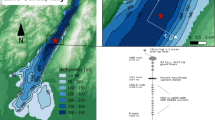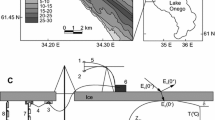Abstract
Nonstationary convection forced by distributed buoyancy sources is a fundamental environmental fluid mechanics process, particularly in ice-covered freshwater waterbodies. In this paper, we present novel field-based results that characterise the diurnal evolution of the main energetics of radiatively-driven convection in ice-covered lakes that is the radiatively-induced buoyancy flux, B, and the kinetic energy dissipation rate, \(\varepsilon\). To estimate the spatiotemporal distribution of \(\varepsilon\), we applied scale similarity of the velocity structure functions to identify the fine turbulence scales from high-frequency velocity measurements. The field study was carried out at Lake Vendyurskoe, Russia, in April 2016. Small-scale velocity fluctuations were measured using acoustic Doppler current profiler in a 2 m layer beneath the ice cover. The method was proven to be valid for low-energy convection without mean shear. The inertial subrange, covering order of magnitude in the spatial domain, was identified by fitting the \(^2/_3\) scaling power law to the structure function method, thus confirming the regime of fully developed turbulence. The calculated rate of dissipation of turbulent kinetic energy \(\varepsilon\) reaches values up to \(3 \times 10^{-9} \hbox { m}^{2}\hbox {s}^{-3}\). Although a strong correlation between \(\varepsilon\) and B was observed, \(\varepsilon\) picks up about 1 h later after the onset of the heating-phase. This delay roughly corresponds to the turnover time of the energy containing eddies. We finally observed a decay of \(\varepsilon\) at night, during the relaxation-phase, but, interestingly, the level remained above the statistical error.






Similar content being viewed by others
References
Bouffard D, Boegman L (2013) A diapycnal diffusivity model for stratified environmental flows. Dyn Atmos Ocean 61–62:14–34
Bouffard D, Zdorovennov R, Zdorovennova G, Pasche N, Wüest A, Terzhevik A (2016) Ice-covered Lake Onega: effects of radiation on convection and internal waves. Hydrobiologia 780(1):22–36. https://doi.org/10.1007/s10750-016-2915-3
Chasnov J, Tse K (2001) Turbulent penetrative convection with an internal heat source. Fluid Dyn Res 28:397–421. https://doi.org/10.1016/S0169-5983(00)00037-X
Deardorff JW (1970a) Convective velocity and temperature scales for the unstable planetary boundary layer and for rayleigh convection. J Atmos Sci 27(8):1211–1213. https://doi.org/10.1175/1520-0469(1970)027<1211:CVATSF>2.0.CO;2
Deardorff JW (1970b) Preliminary results from numerical integrations of the unstable planetary boundary layer. J Atmos Sci 27(8):1209–1211. https://doi.org/10.1175/1520-0469(1970)027<1209:PRFNIO>2.0.CO;2
Farmer DM (1975) Penetrative convection in the absence of mean shear. Q J R Meteorol Soc 101(430):869–891. https://doi.org/10.1002/qj.49710143011
Goluskin D, Poel EPvd (2016) Penetrative internally heated convection in two and three dimensions. J Fluid Mech 791(R6). https://doi.org/10.1017/jfm.2016.69, https://www.cambridge.org/core/journals/journal-of-fluid-mechanics/article/penetrative-internally-heated-convection-in-two-and-three-dimensions/6E0CDCF4FC5FCE07C696EFF3E104DA4F
Hunt JCR (1984) Turbulence structure in thermal convection and shear-free boundary layers. J Fluid Mech 138:161–184. https://doi.org/10.1017/S0022112084000070, https://www.cambridge.org/core/journals/journal-of-fluid-mechanics/article/turbulence-structure-in-thermal-convection-and-shearfree-boundary-layers/17686F1476A274C2D09DCED9FE95B139
Jonas T, Terzhevik AY, Mironov DV, Wüest A (2003) Radiatively driven convection in an ice-covered lake investigated by using temperature microstructure technique. J Geophys Res Oceans 108(C6). https://doi.org/10.1029/2002JC001316, https://agupubs.onlinelibrary.wiley.com/doi/abs/10.1029/2002JC001316
Kadanoff LP (2001) Turbulent heat flow: structures and scaling. Phys Today 54(8):34–39. https://doi.org/10.1063/1.1404847
Kaimal JC, Wyngaard JC, Haugen DA, Coté OR, Izumi Y, Caughey SJ, Readings CJ (1976) Turbulence structure in the convective boundary layer. J Atmos Sci 33(11):2152–2169. https://doi.org/10.1175/1520-0469(1976)033<2152:TSITCB>2.0.CO;2
Kirillin G, Aslamov I, Leppäranta M, Lindgren E (2018) Turbulent mixing and heat fluxes under lake ice: the role of seiche oscillations. Hydrol Earth Syst Sci Discuss, pp 1–22. https://doi.org/10.5194/hess-2018-376, https://www.hydrol-earth-syst-sci-discuss.net/hess-2018-376/
Kirillin GB, Forrest AL, Graves KE, Fischer A, Engelhardt C, Laval BE (2015) Axisymmetric circulation driven by marginal heating in ice-covered lakes. Geophys Res Lett 42(8):2893–2900. https://doi.org/10.1002/2014GL062180
Kolmogorov AN (1941) The local structure of turbulence in incompressible viscous fluid for very large Reynolds numbers. Proc Math Phys Sci 434(1890). http://www.jstor.org/stable/51980
Lenschow DH, Stephens PL (1980) The role of thermals in the convective boundary layer. Boundary Layer Meteorol 19(4):509–532. https://doi.org/10.1007/BF00122351
Lhermitte R, Serafin R (1984) Pulse-to-pulse coherent doppler sonar signal processing techniques. J Atmos Ocean Technol 1(4):293–308. https://doi.org/10.1175/1520-0426(1984)001<0293:PTPCDS>2.0.CO;2
Lilly DK (1983) Stratified turbulence and the mesoscale variability of the atmosphere. J Atmos Sci 40(3):749–761. https://doi.org/10.1175/1520-0469(1983)040<0749:STATMV>2.0.CO;2
Lohse D, Xia KQ (2010) Small-scale properties of turbulent Rayleigh-Bénard convection. Ann Rev Fluid Mech 42(1):335–364. https://doi.org/10.1146/annurev.fluid.010908.165152
Lombardo CP, Gregg MC (1989) Similarity scaling of viscous and thermal dissipation in a convecting surface boundary layer. J Geophysl Res Oceans 94(C5):6273–6284. https://doi.org/10.1029/JC094iC05p06273
Lorke A, Wüest A (2005) Application of coherent ADCP for turbulence measurements in the bottom boundary layer. J Atmos Oceanic Technol 22(11):1821–1828. https://doi.org/10.1175/JTECH1813.1
Mironov D, Terzhevik A, Kirillin G, Jonas T, Malm J, Farmer D (2002) Radiatively driven convection in ice-covered lakes: Observations, scaling, and a mixed layer model. J Geophys Res Oceans 107(C4):7–1–7–16. https://doi.org/10.1029/2001JC000892
Monin AS, Yaglom AM (2013) Statistical fluid mechanics, Volume II: mechanics of turbulence. courier corporation
Nieuwstadt FTM, Brost RA (1986) The decay of convective turbulence. J Atmos Sci 43(6):532–546. https://doi.org/10.1175/1520-0469(1986)043<0532:TDOCT>2.0.CO;2
Obukhov AM, Yaglom AM (1959) On the microstructure of atmospheric turbulence: a review of recent work in the USSR. Q J R Meteorol Soc 85(364):81–90. https://doi.org/10.1002/qj.49708536402
Pandey A, Scheel JD, Schumacher J (2018) Turbulent superstructures in Rayleigh-Bénard convection. Nat Commun 9(1):2118. https://doi.org/10.1038/s41467-018-04478-0
Shay TJ, Gregg MC (1986) Convectively driven turbulent mixing in the upper ocean. J Phys Oceanogr 16(11):1777–1798. https://doi.org/10.1175/1520-0485(1986)016<1777:CDTMIT>2.0.CO;2
Sreenivasan KR (1995) On the universality of the Kolmogorov constant. Phys Fluids 7(11):2778–2784. https://doi.org/10.1063/1.868656
Straus M (1976) Penetrative convection in a layer of fluid heated from within. Astrophys J 209:179–189. https://doi.org/10.1086/154707
Turner JS (1973) Buoyancy effects in fluids by J. S. Turner. https://doi.org/10.1017/CBO9780511608827, https://www.core/books/buoyancy-effects-in-fluids/D1399CD2CE8C5CC7A7141C0C97BF2418
Ulloa HN, Wüest A, Bouffard D (2018) Mechanical energy budget and mixing efficiency for a radiatively heated ice-covered waterbody. J Fluid Mech 852:R1. https://doi.org/10.1017/jfm.2018.587
Wiles PJ, Rippeth TP, Simpson JH, Hendricks PJ (2006) A novel technique for measuring the rate of turbulent dissipation in the marine environment. Geophys Res Lett 33(L21608), https://doi.org/10.1029/2006GL027050
Zdorovennov R, Palshin N, Zdorovennova G, Efremova T, Terzhevik A (2013) Interannual variability of ice and snow cover of a small shallow lake. Estonian J Earth Sci 62(1):26–32. https://doi.org/10.3176/earth.2013.03
Zdorovennov R, Gavrilenko G, Zdorovennova G, Palshin N, Efremova T, Golosov S, Terzhevik A (2016) Optical properties of lake Vendyurskoe. Geogr Environ Sustain 9(3):74–87. https://doi.org/10.15356/2071-9388_03v09_2016_05
Zilitinkevich S (1991) Turbulent penetrative convection. Avebury Technical, Aldershot
Acknowledgements
The present study is a part of the Russian Foundation for Basic Research RFBR, projects 16-05-00436_a and 18-05-60291. GK was supported by the German Research Foundation (DFG Project “IceBound” KI-853/11-1). DB was supported by the FEEL Foundation, Fondation pour l’Etude des Eaux du Léman.
Author information
Authors and Affiliations
Corresponding author
Additional information
Publisher’s Note
Springer Nature remains neutral with regard to jurisdictional claims in published maps and institutional affiliations.
Rights and permissions
About this article
Cite this article
Volkov, S., Bogdanov, S., Zdorovennov, R. et al. Fine scale structure of convective mixed layer in ice-covered lake. Environ Fluid Mech 19, 751–764 (2019). https://doi.org/10.1007/s10652-018-9652-2
Received:
Accepted:
Published:
Issue Date:
DOI: https://doi.org/10.1007/s10652-018-9652-2




